Share this
The New York based artist Tasneem Sarkez, works across various media to create pieces that are united by an elegant marriage of pop culture visuals and potent symbolism. Elements of autobiography combine with broader mainstream signifiers, often nodding to American media and culture, in an ongoing exploration of her own experience of living in the diaspora as an Arab woman. The culture of the internet, with its ability to disseminate and recontextualise images on a global scale, is influential on her practice, as is a more art-historical interest in both romance and poetics. She has described her work as being intended to evoke a feeling of “Apricity,” an old-fashioned word that refers to the experience of feeling the rays of the sun in winter: a revelation of something real and warm hidden beneath the cool, slick surface of commercial imagery.
Text and images by Clyde Nichols.

Clyde Nichols:
Hey Neem
Tasneem Sarkez:
Hi Clyde. What’s up?
CN: It’s great to have a moment to sit and chat. But first, I need an answer to a burning question. Can you give me an honest daily routine? Because, as someone who has your location and regularly checks it, I am constantly perplexed. I never know where your little icon is going to pop up next. At 11:00 a.m. you’re deep in Brooklyn, 2:00 p.m. all the way uptown, 3:00 a.m. at the studio, I check a day later… and you’re in London.
TS: Haha! That’s really funny because yeah, you’re not the first to demand an answer. Honestly, I can trace it back to one moment when my perspective totally switched in terms of how I wanted to live when I moved here. It was after I made a painting of this soccer jersey. The thoughts that came out of that work tied to many realizations that had already been circulating in my head at that point—my relationship to the language of soccer, my dad’s relationship to making it in America under the premise of the immigrant experience, and the memories I had of the speech he gave me the day he dropped me off for college.
There is this extensive history carried in that fact I’m the oldest daughter of a first gen family and that I have to ground myself in all of that. When you’re met with the precedent of your own lineage, it feels impossible to dismiss the depth of what that means. I think I really became fixated on finding that meaning…
Even if it seems trivial, like going to Steinway Street, just so I can go to this specific grocery store for a single can of Palestinian beans to bring to my studio. I will do it. Fulfilling these visions felt right. And I’ll sleep when I sleep. Of course this urgency translates into my practice… and a very unpredictable location.
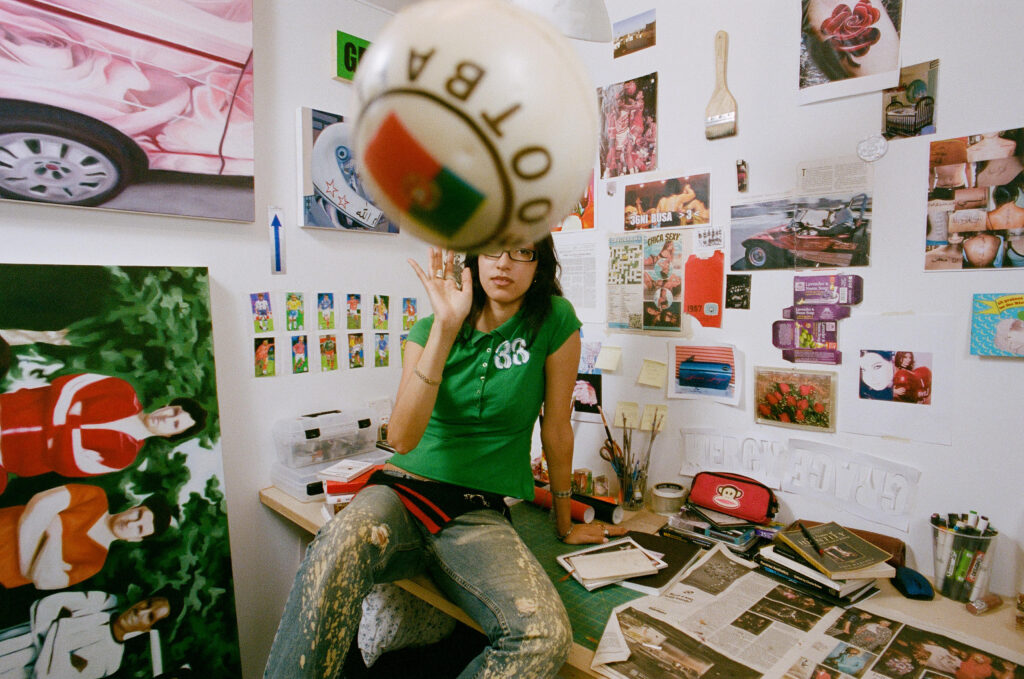
CN: I mean, jokes aside, that’s actually quite powerful. It sounds like that familial connection really placed things in perspective. I’d love to hear you speak a bit more to the soccer jersey piece you mentioned that came in tandem with this new found energy.
TS: Yeah, when I made that jersey and looked at it framed, I realized so much of how my dad had described his relationship to soccer and coming to America lined up. He first came to the States when he was 18 and didn’t know any English. Then, within a year or two, got his first pair of cleats after having played barefoot most his life. He goes through college and plays pickup games until eventually, he’s a referee for kids games in the neighborhood—which mirrors his trajectory of getting more acclimated to America…finding his footing.
Throughout this transition, playing soccer was a way of grounding himself, but also reminding himself of home. So, it was no coincidence that as his kids finally grew up and he could see his life had settled, his knees quite literally gave out.
And now he’s left with all these trophies, medals, and old jerseys for us to look at. I spent a lot of time with one of those jerseys thinking about how the last names on the back call out even when you think no one’s watching. This label becomes a form of signage that points in the direction of your history, while fitting into the gamified world of the soccer game. So the jersey also clicked as an object in terms of what it means to win and lose citizenship, confront the hand you’re dealt, and defend yourself. So much of the lexicon matched everything I had interpreted growing up.
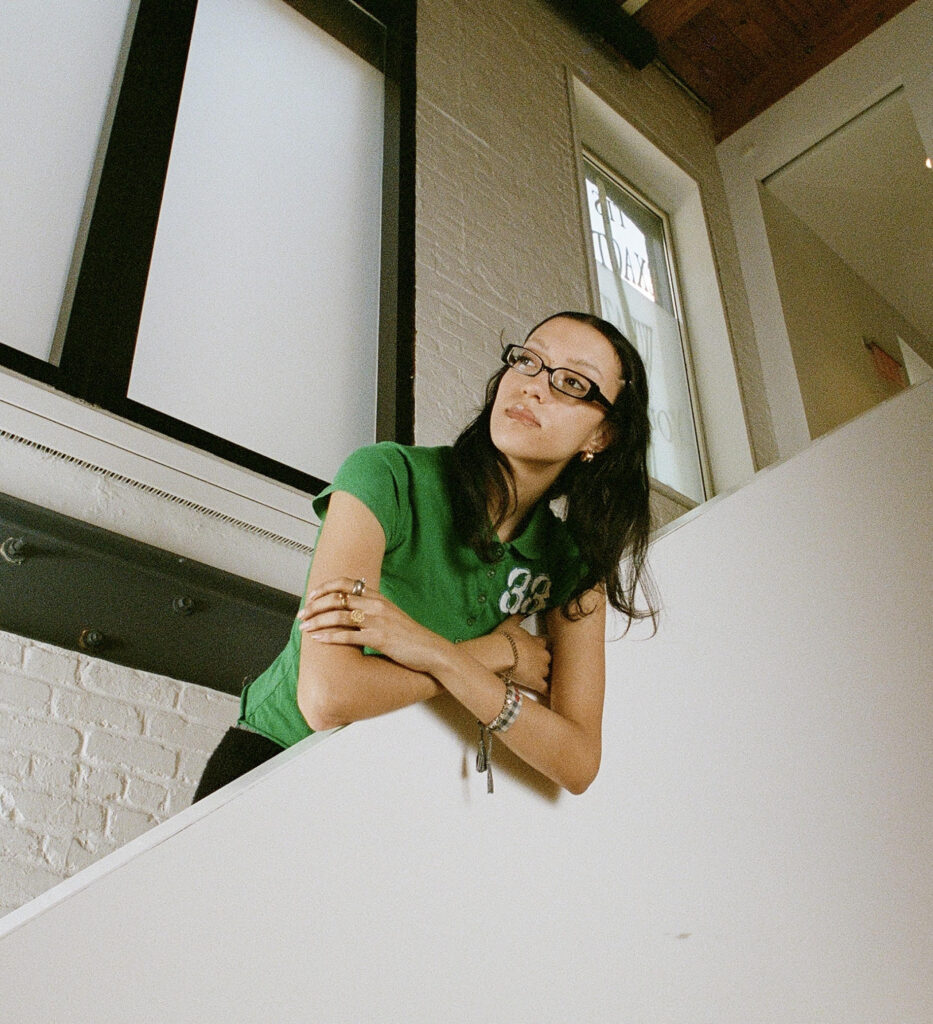
CN: Right, that makes sense. There seems to be these long term resonances—patterns of movement, rules of games, sentimental objects—that merge narrative history with the visual langage of your work. Do any of these boomeranging moments in your family’s story or otherwise stick with you after you make this first work?
TS: Yes totally. My Grandpa only had one request for my Dad when he moved to the states and that was to, “keep the last name clean.” This idea becomes reiterated again, and it’s the sum of all these anecdotes that the structure of a lineage, had led me to my own desire to keep the family name clean.
When we arrived in New York I told my Dad, I find myself right now at the same age as you were when you left for America. How do I compete with that? And my Dad told me, “keep the last name clean.” Just like his dad told him. And I want to uphold that in every essence of the word… the people I meet, the relationships I keep. And the importance of lineage of course comes into play when attaching the family name to artwork, exhibitions, or institutions like the Met.
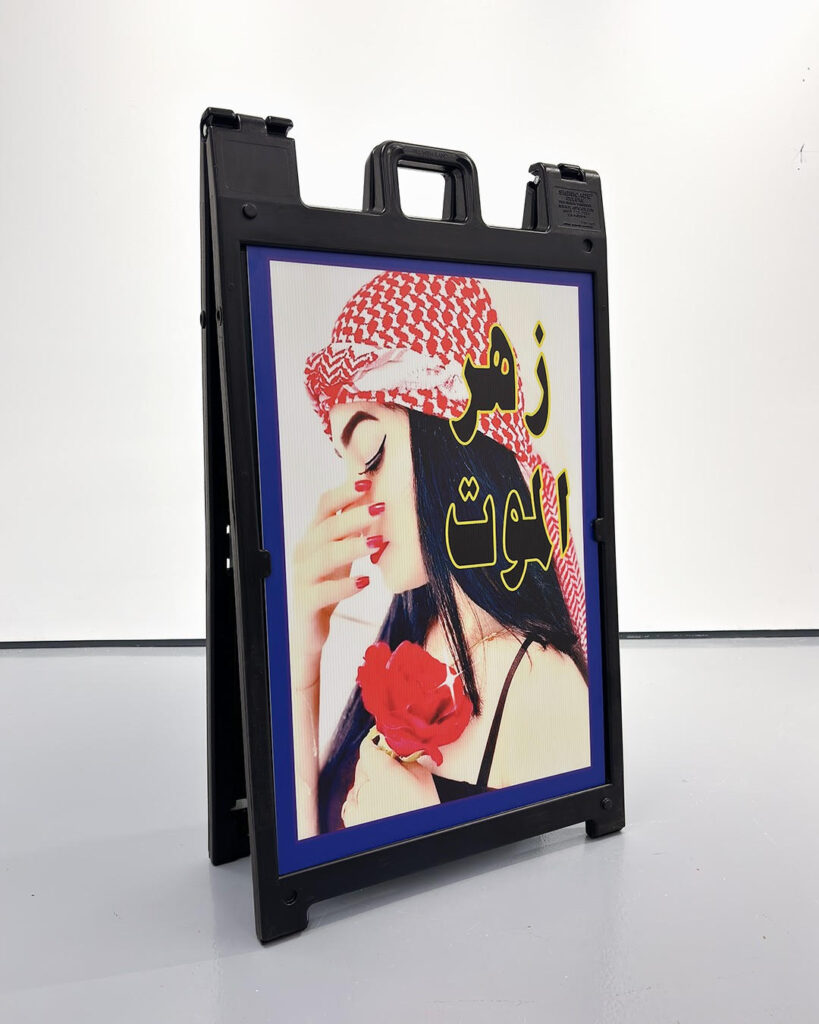
CN: I was looking at some of your newer work like this mouse pad with a youtube thumbnail of your first protest in Portland, and it seems like there’s a theme of pieces that have this digital, physical, and cultural merging. I’m interested in that, how are you thinking about making these physical objects or incorporating this kind of meme or internet culture into these physicalized digital things?
TS: The interest in digital aesthetics primarily came out of simply being in our generation and growing up with the internet. But when you grow up with the understanding of your family being from a certain place, you’d pry into questions about home and then research that. But if the source for answers can’t always be your family and photo albums and asking questions–at that point, it’s the internet.
It becomes another way of finding a cultural link. And when Facebook was invented, that’s when the Arabic chat alphabet became a thing: transliterating numbers to Arabic letters. It’s a distinct chat alphabet that has become the language for a lot of Arabic memes. There’s another side to those memes where beyond the humor, they function so well because they’re a social token that’s accessible and literate in a way that infinitely circulates amongst an ‘in’ and ‘out’ group.
There’s always a string of humor, language, and visuals around internet culture where there’s a pattern and recognizability to it. For me, it leads to a representation of what it means to be a contemporary Arab woman right now. And so that’s why I feel like the internet “meta” aesthetic makes a lot of sense for me and what I’ve noticed for a lot of contemporary Arab artists alike.
If I’m able to articulate a composition that mediates between these internet portals and the art historical; the reciprocity of all these things is what keeps me engaged, and keeps people engaged with the work as well.

CN: Absolutely. I’d also love to talk about the car paintings. I want to hear your thoughts about the garish, or ironic symbols of Americana…like ‘the eagle’ or ‘the flag’ or ‘the bumper sticker’ that often populate the paintings. And I want to know what you think about the way these symbols merge in the physical and metaphorical space of the car.
TS: The interest in cars came from what I talked about earlier with developing this eye for patterns and the cultural recognition in everyday things. I’m always taking photos for inspiration on my walks through the city and I had noticed a super-abundance of cars. In an attempt to figure out what was drawing me to them, I tried to pick out one thing from each car to explain why I took a photo. Then I realized that in every photo some aspect of the car had reflected a part of myself that I had seen.
The car is a venue where you’re quite literally professing to the world, “I care about this idea or this thing so much that I want you to see this car and know that I’m all about this thing.” Identity is being reflected in the object. And I feel like I find a lot of clarity in the way objects can act as proxies to personify engagement between a person and their values.
There’s also so much to speak about in the automotive industry of the Arab world: oil, power, money, and even drifting culture. Drifting in the Arab world is the physical act of taking all these Western objects and wrecking them. So you destroy an object of the West out of pleasure and joy as this act of revolution. I guess what I’m saying is that the cars opened up this rabbit hole of a system of thought around mechanics, identity, and what the hybridity of that looks like.
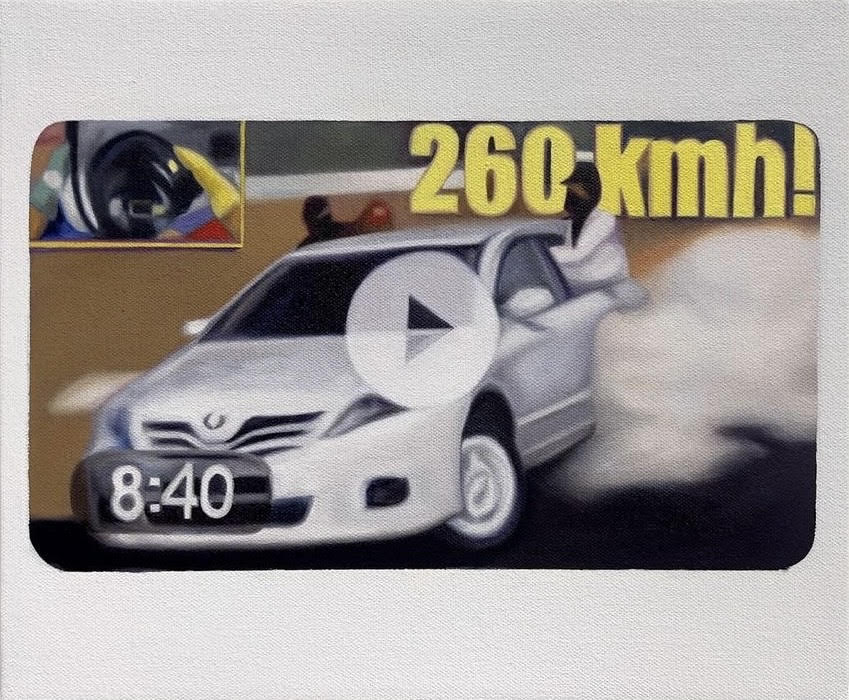
CN: Right. It seems the car is a helpful metaphor for this complex internet-era Arab existence where the substrate of this mechanical object can provide a rubric for personalizing the world against the destructive acceleration of a western vision of machines, movement, and civic infrastructure. Your painting’s take the substrate of ‘the window’ or ‘the bumper’ or ‘the door’ and then use vinyls and the stickers containers for information about the ways that identity is mirrored or reflected—forced to fit into the sort of frame of the car as a structural object.
TS: Exactly, because that’s what it feels like. I’m also just doing what I feel like it is, you know, a process of layering. An image of an image of a layer or a layer etc. In the newest versions I’m beginning to have the audience wonder, is that real, is it made, what does it mean for it to be imagined?
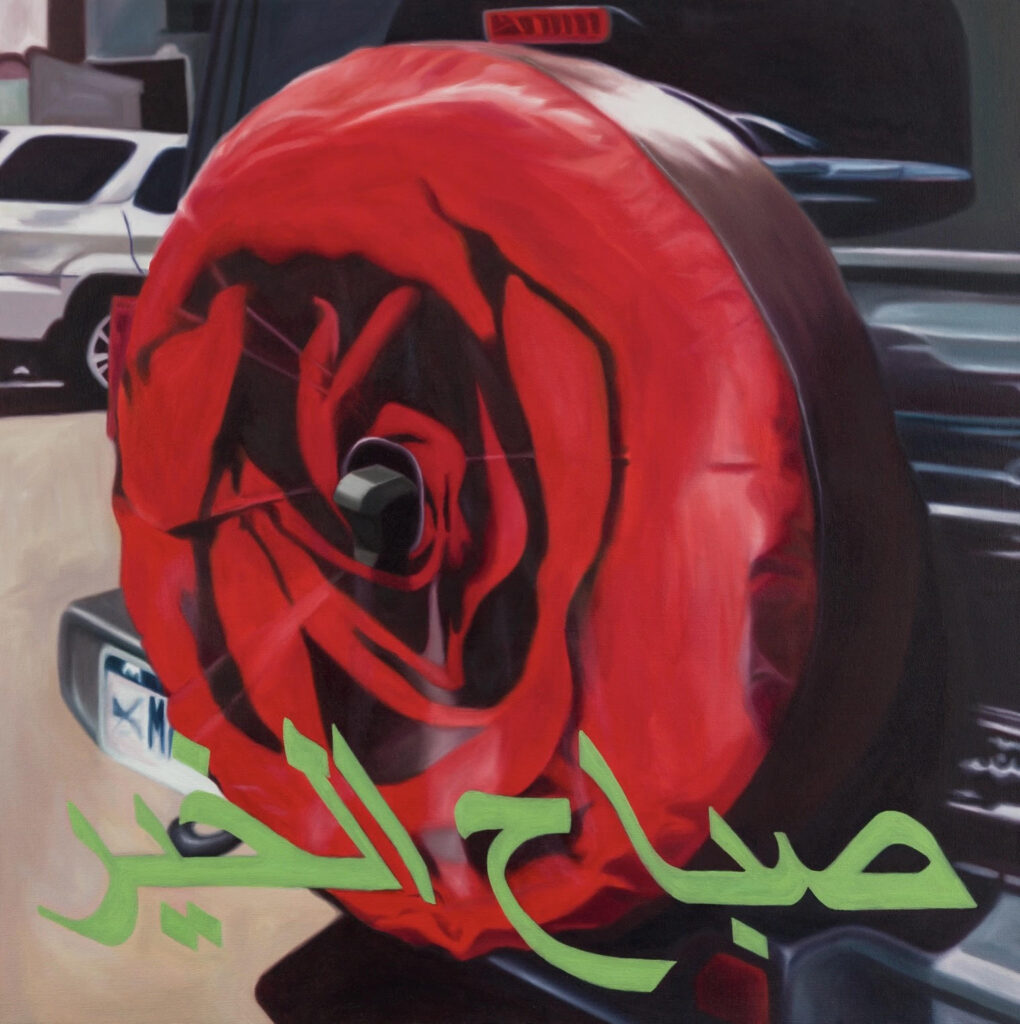
CN: I can’t wait to see that unfold. These are objects within which smaller dramas can play out and you get to experiment and merge into new messages. That’s the next step. Speaking of collaging and collecting ideas I’d like to turn to music specifically. I know you for your encyclopedia knowledge of Habibi Funk but how does music relate to your art practice and thinking more broadly?
TS: I remember when I, within the first year of living here, I had a lot of thoughts about how I’m left to my discretion of defining home, like physically in my apartment, or in the food that I eat, the music I listen to. And I was really like, perplexed with, I don’t know, just the question of like, what is home? What do I take, what do I leave behind?
I was talking to a friend of mine, also from Portland, who had grappled with the same question, and had already been in New York for a while. She told me to reach towards those cultural signifiers, whether it be food, jewelry or even music that draw upon some kind of pride and lean into that even if it feels ‘wrong’ at first.
At first starting to learn about music became that gateway for me to combat some of the intense overwhelm of trying to parse through mountains of possible research, traditions, and culture. I was like, you know what, like, I know a lot about Arab classical music, but there has to be another genre I can get more down with. And that’s when the song ‘Ayonha’ by Hamid Al Shaeri fell into my lap.

Every time I listened to it, it was almost meditative, and then finding out the singer is Libyan too made me proud in a way I wasn’t used to. If there is one last song on my deathbed, you know, when the people are like “what’s your execution?” meal…if I had an execution song, it’s that one.
I titled my first book ‘Ayonha’ to encapsulate the imagery of this feeling of almost being born-again, this archival collection of drawings, photos, and collages that have the same feeling of wonderment and innocence. Which is now permanently collected by the MET’s library, and that acquisition cemented that song for me quite literally forever but also in its significance in the song and the genre it represents.

CN: I mean, from my perspective, your exploration of music is one of the many ways you build a world around your practice and dedicate yourself to the act of collecting.
TS: I felt like in Portland, I had no agency and it was hard to realize that, in retrospect, I could have been more proactive, but it’s hard when the rest of the world around you doesn’t want you to be. I literally tell people that I did not start living until I moved here. It’s a unique experience to grow up in the Pacific Northwest as this hyper mesocosm of whiteness that places identities on a clear spectrum of value, visibility, and respect. So if you exist at any point further down the line from the platonic ideal of the ‘perfect white American’ you can feel it, it permeates you. So I guess I am trying to reverse the effects of that now in my early twenties, playing music, or reading books that could almost feel like oversaturating my intake of identity. But it’s literally the difference between living and existing. I’m so young. Like, there’s so much to read so much to listen to and it feels like I’m just now getting started.
